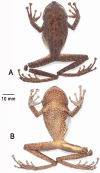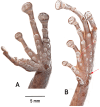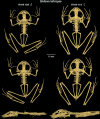Head in the clouds: two new microendemic tepui-summit species of Stefania (Anura: Hemiphractidae)
- PMID: 39090696
- PMCID: PMC11295383
- DOI: 10.1186/s40851-024-00237-w
Head in the clouds: two new microendemic tepui-summit species of Stefania (Anura: Hemiphractidae)
Abstract
In addition to the type locality (the summit of Aprada-tepui, Bolívar State of Venezuela), the distribution of the egg-brooding frog Stefania satelles was long thought to include several isolated tabletop mountain (tepui) summits surrounding the large Chimantá Massif in Bolívar State (hence the Latin name "satelles"). However, multilocus molecular phylogenetic analyses have revealed that this taxon includes several undescribed morphologically cryptic species, and that S. satelles should be restricted to its type locality. Two tepui-summit species confused under that name in the literature remain to be named, and the present paper aims at describing these populations previously referred to as Stefania sp. 3 and S. sp. 5. Stefania sp. 3 is only known from the small summit of Angasima-tepui, while S. sp. 5 is only reported from the small summit of Upuigma-tepui, both mountains being located south of the Chimantá Massif. These new, phylogenetically distinct species are described based on external morphology and osteology and in comparison to close relatives in the S. ginesi clade, which consists exclusively of tepui summit species. Both new species have highly restricted geographic ranges (less than 3 km2) and should be listed as Critically Endangered according to IUCN criteria.
Keywords: Homoplasy; Morphology; Osteology; Pantepui; Systematics; Taxonomy.
© 2024. The Author(s).
Conflict of interest statement
Not applicable.
Figures















References
-
- Frost DR. Amphibian species of the World: an online reference. Version 6.2 (accessed 29 February 2024). New York, USA: American Museum of Natural History; 2024. https://amphibiansoftheworld.amnh.org/index.php. Electronic Database accessible at.
-
- Duellman WE. Marsupial, Frogs: Gastrotheca and Allied Genera. Baltimore: Johns Hopkins University; 2015.
-
- Jungfer K-H, Boehme W. The back-pack strategy of parental care in frogs, with notes on froglet-carrying in Stefania evansi (Boulenger, 1904) (Anura: Hylidae: Hemiphractinae). Rev Fr Aquar Herpetol. 1991;18:91–6.
-
- Means DB, Duellman WE, Clark VC. Ovipositing behavior in the egg-brooding frog Stefania ayangannae (Anura, Hemiphractidae). Phyllomedusa. 2008;7(2):143–8. 10.11606/issn.2316-9079.v7i2p143-148 - DOI
-
- Kok PJR. Islands in the Sky: species diversity, evolutionary history, and patterns of endemism of the pantepui herpetofauna. PhD thesis, Leiden University, the Netherlands; 2013.
Grants and funding
LinkOut - more resources
Full Text Sources

